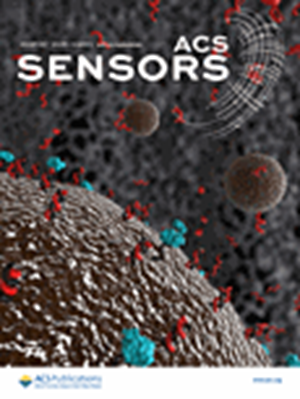Controlled Assembly of Bimetallic PtRh-Modified Tin Oxide Hollow Nanotubes with High Sensing Activity for Ultrasensitive Formaldehyde Detection
IF 8.2
1区 化学
Q1 CHEMISTRY, ANALYTICAL
引用次数: 0
Abstract
Gas sensors for rapid identification of formaldehyde (HCHO) exposure risks are of great significance, given the volatility, toxicity, and near-imperceptibility of HCHO. However, the precise design of highly reactive sensing materials remains a substantial challenge that limits the application of gas sensors. Here, PtRh-modified tin oxide (PtRh/SnO2) hollow nanotubes with an open hollow nanostructure and bimetallic sensitization are proposed for regulating the reactivity to achieve ideal improvement in HCHO-sensing performance. The prepared 1.5% PtRh/SnO2 hollow nanotube-based sensor achieves a high sensing response (Ra/Rg = 265.8–25 ppm of HCHO), fast response and recovery rate (2.6 and 6.1 s), good selectivity, and strong anti-interference toward HCHO at 200 °C. Based on the ex/in situ characterizations and density functional theory (DFT) calculations, the enhanced sensing properties are mainly attributed to the construction of hierarchical hollow nanostructures providing sufficient active sites for gas absorption, as well as the oxygen spillover effect from Pt, the catalytic property of Rh, and their synergistic effects. Hence, the architecture demonstrates enhanced adsorption capacity and interfacial reactivity toward HCHO, thereby improving the sensing response and selectivity. In addition, the PtRh/SnO2 sensor was used to monitor the HCHO in oysters, providing promising applications in real-time aquatic product HCHO monitoring.

用于超灵敏甲醛检测的高传感活性双金属ptrh修饰氧化锡空心纳米管的控制组装
考虑到甲醛(HCHO)的挥发性、毒性和几乎不可感知性,用于快速识别甲醛暴露风险的气体传感器具有重要意义。然而,高反应性传感材料的精确设计仍然是限制气体传感器应用的重大挑战。本文提出了具有开放空心纳米结构和双金属敏化的PtRh修饰氧化锡(PtRh/SnO2)空心纳米管,用于调节反应性,以达到理想的hho敏化性能改善。制备的1.5% PtRh/SnO2空心纳米管传感器在200℃下对HCHO具有高的传感响应(Ra/Rg = 265.8 ~ 25 ppm的HCHO)、快速的响应和快速的回收率(2.6 s和6.1 s)、良好的选择性和较强的抗干扰性。基于迁地/原位表征和密度泛函理论(DFT)计算,传感性能的增强主要归因于分层中空纳米结构的构建,为气体吸收提供了足够的活性位点,以及Pt的氧溢出效应、Rh的催化性能及其协同效应。因此,该结构对HCHO的吸附能力和界面反应性增强,从而提高了传感响应和选择性。此外,将PtRh/SnO2传感器用于牡蛎体内HCHO的监测,在水产品HCHO的实时监测中具有广阔的应用前景。
本文章由计算机程序翻译,如有差异,请以英文原文为准。
求助全文
约1分钟内获得全文
求助全文
来源期刊

ACS Sensors
Chemical Engineering-Bioengineering
CiteScore
14.50
自引率
3.40%
发文量
372
期刊介绍:
ACS Sensors is a peer-reviewed research journal that focuses on the dissemination of new and original knowledge in the field of sensor science, particularly those that selectively sense chemical or biological species or processes. The journal covers a broad range of topics, including but not limited to biosensors, chemical sensors, gas sensors, intracellular sensors, single molecule sensors, cell chips, and microfluidic devices. It aims to publish articles that address conceptual advances in sensing technology applicable to various types of analytes or application papers that report on the use of existing sensing concepts in new ways or for new analytes.
 求助内容:
求助内容: 应助结果提醒方式:
应助结果提醒方式:


